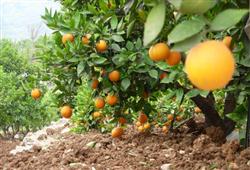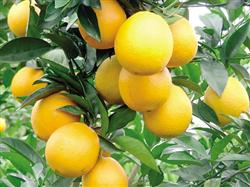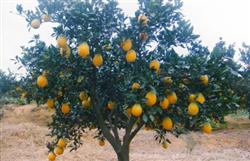How to manage the cultivation of navel oranges?

How to manage the cultivation of navel oranges? Please give a comprehensive introduction to the cultivation of navel oranges can be managed with reference to the following methods: (1) the mineral nutrients and water needed for soil management of navel orange trees are mainly absorbed from the soil through roots. Soil is not only the basis of the growth and development of navel orange, but also the storage of fertilizer and water. Therefore, the essence of soil management is to coordinate water, fertilizer, gas and heat in soil, form a virtuous circle of soil environment, promote the development of navel orange roots, and enhance the ability of drought and cold resistance of trees, so as to achieve early fruiting and high yield, high quality and high yield. The main results are as follows: 1. The main soil types in the mountains and hills of southern Jiangxi are red soil, yellow soil and purple sandy soil, which are characterized by acid, plate, thin, sticky and dry. Therefore, no matter whether it is flat land, hills or mountains to build a new garden, we must adhere to the principle of changing the soil first and then planting it. However, the deep turning of the planting hole (ditch) can not be done once and for all. With the extension of the root system, the expansion of the tree crown and the increase of yield, we must constantly improve the garden soil, improve the fertility and maintain the exuberant vitality of the tree. In order to achieve this goal, the whole garden must be expanded and improved in a planned way according to the law of growth and development of navel orange trees. The main results are as follows: (1) the method of hole expansion and soil improvement is to turn outward and deeply along the outside of the fixed planting ditch or the last expansion ditch, requiring no partition wall to see the root, so as to avoid damaging too many fibrous roots; the hole expansion ditch is 60 cm wide and 60 cm deep; 20 kg of crude organic fertilizer is buried in layers per cubic meter, and cake fertilizer and phosphate fertilizer are added near the crown. (2) time: expanding holes and improving soil can be carried out in four seasons on the premise of not hurting roots as much as possible. In practice, filling materials and labor should be arranged according to the specific conditions and requirements, and the soil improvement of the whole garden should be completed in 2 ~ 3 years. It should be avoided in the period of vigorous growth of new shoots, vigorous growth of young fruits, low soil temperature in winter, high temperature and drought season. In Gannan, the production garden is generally carried out from September to November after the autumn shoot is mature, while in the unfinished young navel orange orchard, the spring shoot can be carried out until the middle of November. 2. Intercropping and grass-growing navel orange orchard can improve soil structure, continuously improve soil organic matter and fertility, reduce chemical fertilizer input, prevent soil erosion, preserve fertilizer, preserve water and drought, adjust air temperature, promote navel orange to maintain normal physiological activities, promote navel orange growth, and significantly improve fruit yield and quality. Attract a large number of natural enemies, improve the biological control ability of navel orange orchard, reduce the damage of diseases and insect pests and reduce the use of pesticides. It is the green food fruit industry production and extension technology of the Ministry of Agriculture, and is designated as the national agricultural introduction of foreign intellectual achievements demonstration and extension project and "948" agricultural technology introduction project. Orchard intercropping: young navel orange orchard, small crown, can be used to interplant cash crops, such as peanuts, legumes, purple yunying (safflower), fertile field radish, etc., not suitable for interplanting tobacco, corn, watermelon, sweet potato and other tall stalks and vines. (1) Natural grass: on the premise of thoroughly removing malignant weeds in navel orange orchards, benign weeds, such as dandelion, dogtail grass, thistle and so on, are naturally stored outside the tree plate. (2) artificial recommendation: after thorough elimination of weeds in the field, grass species with strong adaptability, large amount of fresh grass, short stalk and shallow roots are artificially planted outside the tree plate, which are beneficial to the breeding and reproduction of natural enemies of insect pests, such as clover, peanut grass, ryegrass and so on. Bahia grass can be planted on the ladder wall. Points for attention in grass cultivation: (1) can not have the same kinds of diseases and insect pests as navel orange; (2) can not be persistent root malignant weeds such as Bermudagrass, thatch, aconite, etc. (3) the vigorous growth period of grass should not be synchronized with that of navel orange. The combination of grass cultivation and tree plate mulching: when the weeds are 50-60 cm, cutting in time for tree plate mulching can not only maintain soil moisture, stabilize soil temperature, improve soil structure, maintain soil looseness and air permeability, but also increase soil microbial activity and promote plant growth. Note that the thickness of the mulch must reach 10 cm to 20 cm, otherwise it will not have the effect of moisturizing and drought resistance; the other is that there must be a gap of about 10 cm around the rhizome of the tree bag, so as to avoid the disease of the rhizome caused by the rot of the mulch. The tree disk mulch can be buried deeply when expanding holes to improve soil or fertilizing in winter. For orchards cultivated with grass, chemical weeding can also be used to cover the whole orchard before the advent of high temperature and dry season in summer. The first is to pay attention to the concentration of chemical weeding should not be too high, the second is not to use more than 2 times in the whole year, so as not to adversely affect the soil and environment, and the third is to ensure the safety of branches and leaves, especially fruits. (2) there are several mineral nutrient elements needed for the normal development of navel orange trees under fertilizer management, including six essential elements such as nitrogen, phosphorus, potassium, calcium, magnesium and sulfur, and six trace elements such as boron, zinc, manganese, iron, copper and molybdenum. Navel oranges have two sources of nutrition. One is that the leaves carry out photosynthesis to produce a lot of organic nutrients, and the other is that the roots absorb a lot of mineral nutrients from the soil. The inherent nutrition in the soil is limited and needs to be supplemented by continuous fertilization, which is the fertilization management of navel orange orchard. 1. The principles of fertilization in navel orange orchard: (1) combining the different conditions and changes of soil, tree condition and weather, using the combination of mature organic fertilizer and inorganic fertilizer, mainly mature organic fertilizer; (2) the combination of nitrogen, phosphorus and potassium with other nutrient elements. Promote leaf nutrition diagnosis and formula fertilization; (3) correctly grasp the amount of fertilizer application, fertilization period and methods to improve fertilizer utilization efficiency and prevent fertilizer damage. 2. Fertilization methods: (1) soil fertilization: soil fertilization can be divided into moving soil fertilization and immobile soil fertilization. Dynamic soil fertilization method: ① strip ditch application: at the outer edge of the crown dripping line, strip ditches are opened on the opposite sides, and fertilizer and soil are mixed evenly into the ditch, and the position is changed each time; ② ring ditch application: open ring ditches along the outer edge of the crown drip line, mix fertilizer and soil into the ditch, and change the position each time. ③ radial ditch application: start at a certain distance from the tree trunk within the crown projection range, dig 4-6 shallow and deep radial fertilizer ditches outward, apply fertilizer and soil evenly in the hole, and change the position each time; ④ hole fertilization: dig several fertilizer holes in the crown projection area, mix fertilizer and soil evenly in the hole, and change the position each time. Immobile soil fertilization method: ① tree plate application: in the rainy season in spring and summer, apply quick-acting fertilizers such as urea and compound fertilizer on the tree plate before (or immediately after rain). The application of chemical fertilizer to trees should be done a small amount for many times, not too much at one time, so as to avoid serious loss when the rainfall is heavy; fertilizers should be spread evenly, not concentrated in one place, especially not too close to the trees; be careful not to spread fertilizer on the branches and leaves; young navel orange trees before and after fertilizer application, it is best to loosen the tree plate properly to prevent topsoil from hardening. ② water and fertilizer application: after the mature organic fertilizer is diluted with water, it is applied to the crown. Fertilizer can be used such as withered cake, human and animal feces and urine, which must be completely mature before application; the concentration of fertilizer should be strictly controlled in water and fertilizer application to prevent fertilizer damage caused by excessive concentration. Taking rotten cake fertilizer as an example, the concentration of rotten cake fertilizer is recommended to be about 1%, with a maximum of 1.5%. Quick-acting chemical fertilizers such as urea and compound fertilizer can be appropriately added to organic water and fertilizer, and the concentration of chemical fertilizer should be controlled below 0.5%. If water and fertilizer is used, in order to prevent the root system from floating, the amount of water and fertilizer applied to adult trees shall not be less than 50kg each time, and the young trees shall be poured thoroughly. In order to reduce the loss of water and fertilizer and make the water and fertilizer penetrate deeply, we can also dig a 15-20 cm deep or annular ditch on both sides of the outer edge of the crown dripping line, pour water and fertilizer into the ditch, and after it is completely infiltrated, cover with a layer of thin soil to reduce evaporation, after so many times, finally fill the fertilization ditch completely. (2) the ions or components of certain nutrient elements that are dissolved in water by topdressing. Commonly used concentration of extra-root topdressing: urea: 0.2-0.3% (diuretic content in urea)
- Prev

How to fertilize Fuchuan navel orange?
How to fertilize Fuchuan navel orange? Please give guidance to Fuchuan navel orange fertilization there are two kinds of soil fertilization and extra-root topdressing, mainly soil fertilizer, fertilization methods are as follows: (1) soil fertilization: soil fertilization should not only facilitate the root system to absorb fertilizer as soon as possible, but also prevent the root system from suffering fertilizer damage. Therefore, fertilization should be done according to time and tree.
- Next

What is the effect of various fertilizers on navel oranges?
What is the effect of various fertilizers on navel oranges? Please give a detailed description of navel oranges like other oranges, their growth results need adequate nutrient supply, there are 16 necessary nutrients. According to the requirement of mineral elements, it can be divided into a large number of elements (nitrogen, phosphorus, potassium), medium elements (calcium, magnesium, sulfur) and trace elements.
Related
- Moge, come on! The staff of the peasant association in the producing area of cantaloupe were frightened when the crowd gathered.
- Causes and Solutions of low Fruit setting rate of Apple
- Symptoms and control measures of passion fruit virus disease
- Fruit growing lesson: how do apple orchards keep high yields?
- Can you build orchards in the mountains? What are the pros and cons?
- How to manage the coloring period of Crisson grape?
- This paper introduces the processing technology of two kinds of fig products.
- How much is a month for retired teachers in rural areas by 2020?
- How can strawberry planting increase sugar content? We should pay attention to management in many aspects.
- What are the cultivation techniques on how to improve the yield of golden fruit?

